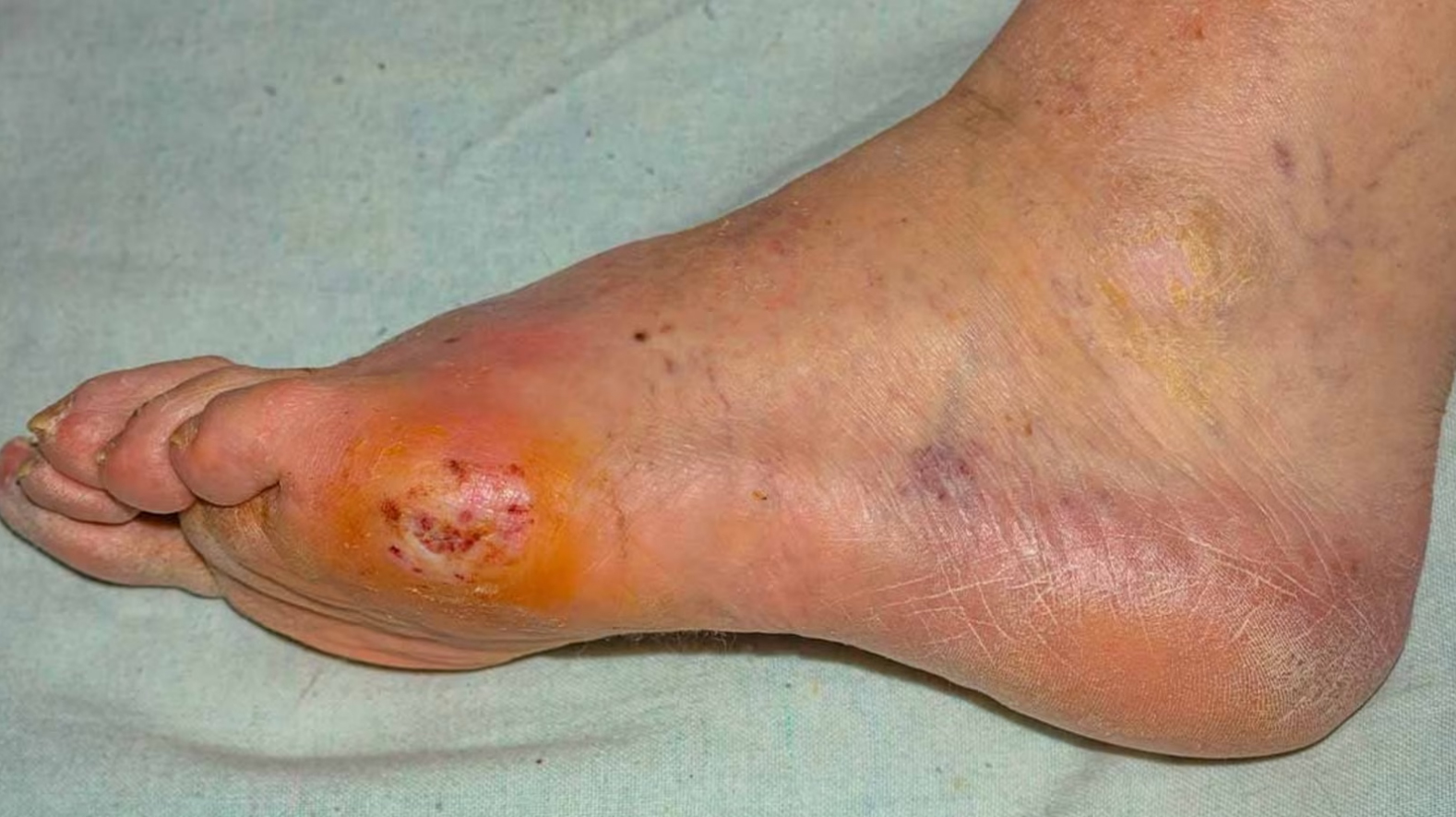
Diabetes – Foot sores and Infection
What are diabetic foot complications?
Having diabetes increases your risk for foot sores and infections. The problems can range from minor sores to permanent damage to the foot. In severe cases, the foot or even the leg may have to be amputated. Proper wound care is crucial for individuals with diabetes, as it helps reduce the risk of foot sores and infections that can lead to severe complications. By adopting proactive measures to care for your feet and legs, such as regular inspection, keeping the area clean and dry, using appropriate footwear, and seeking timely medical attention, you can significantly lower the chances of infection and mitigate the potential need for amputation.
How do they occur?
When you have diabetes, you may have poor blood flow to your feet. This makes it harder for your feet to fight infections and heal from injuries. As a result, infections and sores on your feet are more likely to become serious. Without treatment, severe infections can cause the flesh of your foot to die (gangrene). People who have diabetes are 20 times more likely to have gangrene in the foot than people who do not have diabetes.
Because diabetes damages nerve endings (a problem called neuropathy), you may not feel pain if you hurt your foot or get an infection. This can make it hard for you to know when you need medical treatment. This is why it is so important for you to check your feet every day.
Together, these problems make it easy to get sores and infections
What are the symptoms?
The first symptoms of an injury or infection may be swelling or redness. Another possible symptom is pain, but often people who have diabetes cannot feel pain in the foot. Sores may appear on the skin of your foot. They may heal but later come back in the same place. If the sores are not treated, the flesh may die and turn black.
How are they diagnosed?
Your healthcare provider will suspect that you are developing a sore if there is an area of redness or a blister on your foot. Most often sores are on the bottom of the foot or on the toes. However, they can be anywhere there has been unusual pressure (such as from a wrinkle in your sock) or an injury (such as from a sharp corner of a toenail).
Your provider may swab the sore to test for bacteria.
Sometimes sores are much larger than they look. Your provider will need to see how deep the sore is. You may need an X-ray to make sure the bone is not infected.
How are they treated?
Your provider may prescribe antibiotics or other medicines to put on the sore or infected part of your foot. The medicine will help fight infection, get rid of dead flesh, and help new, healthy flesh to grow. Your provider may also prescribe an antibiotic to be taken by mouth.
You may have to stay off your feet for a while to prevent further irritation of sores or infection. You may also need to keep your foot raised on a stool or pillow to help the blood flow better. Your provider may recommend physical therapy treatments, such as whirlpool baths, to help your foot heal. The therapist may also check how you are walking and how well your shoes fit. Sometimes a foot specialist (podiatrist) may help with your foot care.
In some cases, you may need to stay at the hospital for treatment. If antibiotics do not heal the infected area, your provider may have to remove the infected flesh surgically. In an extreme case, if you have gangrene, the affected part of your foot may need to be removed.
How long will the effects last?
As long as you have diabetes, you will be at risk for foot infections. It is important for you to take good care of your feet to lessen the risk of infection and complications and loss of your foot or leg.
How can I help prevent diabetic foot complications?
Check your feet every day.
Look at your feet at the end of each day to check for reddened areas, cuts, or scrapes that could become infected. If you cannot see the bottom of your feet, use a mirror or ask someone for help. You can also use your hands to feel for hot areas, bumps, or sensitive (tender) areas. Check for such things as:
- changes in the color or temperature of your toes or feet
- changes in the bony shape of the toes or feet (you can even have a broken foot bone and not be able to feel it)
- new numbness or loss of feeling in the toes or feet
- a buildup of corns, calluses, and blisters
- dry, or cracked skin or skin that does not look normal
- open sores.
Look for signs of infection in a cut or blister. Signs of infection include:
- redness
- an area that feels warmer than other, nearby skin
- tenderness or pain when the infected area is touched
- pus coming out of a cut or blister
- red streaks heading up your leg from the cut or blister
- inflamed (swollen and red) ingrown toenail.
See your healthcare provider at the first sign of any foot problems.
Keep your feet clean and dry.
- Wash your feet every day with soap and warm (not hot) water. Then dry your feet carefully with a soft towel, especially between the toes. After your feet are dry, put lanolin or a lotion recommended by your provider on your feet to keep the skin soft and free of scales. Do not put lotion between your toes because it may keep the skin in that area too moist.
- If your feet sweat a lot, keep them dry by dusting them with talcum powder.
Treat corns and calluses.
- Don’t treat corns or calluses yourself.
- Tell your healthcare provider right away if you have a corn or callus.
- Don’t use nonprescription products for these problems unless your healthcare provider says it is OK.
Care for your toenails.
- Clean your nails carefully.
- Cut your toenails carefully. Cut them straight across. Do not cut the corners of the nails, the hardened skin at the corner of the nail, or the cuticles.
- If your nails are hard to trim, ask your healthcare provider’s office for help.
Protect your feet from hot and cold.
- Don’t use hot water bottles, electric blankets, or electric heaters to warm your feet. Because you may not feel hot and cold with your feet, you may burn your feet accidentally and get an infection. Wear cotton socks to bed if you need extra warmth for your feet.
- Avoid putting your feet where they could accidentally be burned; for example, on hot sand at the beach; in hot bath water, hot tubs, or whirlpools; or near a fireplace.
Choose good footwear.
- Always wear foot protection, especially on rough surfaces.
- Wear soft leather shoes that fit properly.
- Ask your healthcare provider about specially made shoes if you have foot problems.
- Avoid wearing new shoes for more than an hour a day until they are thoroughly broken in.
- Wear clean cotton socks and change them at least once a day.
- Never walk barefoot. Keep slippers by your bed to use when you get up at night.
Keep good blood flow in your feet.
- Stand up if you have been sitting for a long time, for example, at a desk.
- Wiggle your feet and toes 2 to 3 times a day.
- Get the blood flowing by putting your feet on the floor and lifting your heels 10 times.
- Avoid sitting with your legs crossed.
In addition to these foot care guidelines, good control of your blood sugar and your blood pressure help prevent foot problems.
Do not smoke because it causes poor blood flow and slows the healing of wounds.
See your healthcare provider at least every 3 months. You should have a foot check at each of these visits. Be sure to see your provider sooner if you have a red area or sore. Once a year your provider should check your feet for nerve damage. If you lose the ability to feel things on the skin of your feet, then you will need to take extra precautions to prevent injury.
Foot Instructions For Diabetic Patients
- Inspect your feet daily for blisters, bleeding or lesions between toes. Use a mirror to see the bottom of the foot and the heel.
- Have a family member or friend check your feet if you are unable to do so.
- Have regular foot examinations by your diabetic foot care specialist.
- Always remove both shoes and stockings when visiting your doctor.
- Always wear well fitted stockings or socks with your shoes. Padded hosiery may reduce pressure and be more protective.
- Inspect the soles and insides of your shoes for foreign objects before putting them on.
- Shoes should be properly measured, comfortable and easy to put on at the time of purchase.
- Wear leather shoes with adequate room for the toes. Running or athletic shoes are best for recreational walking.
- Change shoes every 4 to 6 hours.
- In cold weather, wear insulated boots or heavier socks. Be sure the shoes allow enough room to allow for heavier socks.
- If you’ve lost sensation, do NOT walk barefooted in the house, outside or at the beach.
- Do NOT use hot water bottles or heating pads to warm your feet, use warm socks.
- Do NOT soak your feet.
- Do NOT use acids or chemical corn removers
- Do NOT perform “bathroom surgery” on corns, calluses or ingrown toenails.
- Wash feet daily and be sure to dry well between toes. Apply moisturizing cream liberally, but avoid between toes.
- Test the temperature of the bath water with your ELBOW or THERMOMETER. Do NOT let hot water drip onto your toes.
- Call your wound care specialist or primary care provider immediately if you detect a new lesion of if your foot becomes swollen, red or painful. Stay off your foot until you see your doctor.
- Learn all you can about your diabetes and how it can affect your feet.
- Maintain good diabetes control and do not smoke.
Talk to your infectious disease wound care specialist podiatrist/Primary care provider/ vascular specialist /diabetologist.
